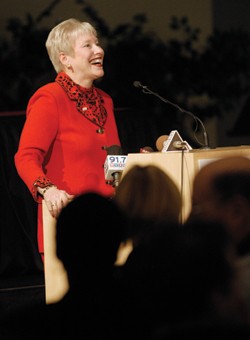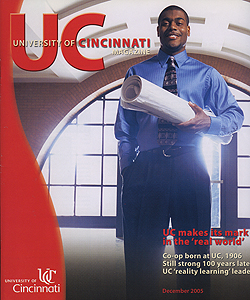President's column

by UC President Nancy L. Zimpher
Just when we were getting used to the Knowledge Economy, it's being eclipsed by something else: the creative, or innovation, economy. Call it what you will, many experts say it's the single most important challenge facing the 21st century.
Without question, the University of Cincinnati is uniquely positioned to meet this issue head on, especially as we pursue our UC|21 vision to define the new urban research university. One of the primary reasons UC is so well situated on the innovation front is our long and ongoing commitment to "real world" learning.
That commitment reaches back 100 years as this academic year marks the centennial celebration of UC's founding of cooperative education. Our board of trustees, in fact, launched the co-op celebratory year in September by proclaiming this 100-year "experiment" a rousing success.
Co-op has proven to be such a great idea that Herman Schneider's groundbreaking notion of combining higher learning with real-world experience is a concept now emulated at more than 1,500 institutions worldwide. Looking to the next 100 years with UC's renewed commitment to co-op and other forms of reality learning, our institution is well on its way to being equally cutting-edge -- just in time for the innovation economy.
In my recent State of the University address, I outlined four pathways I believe will prove vital as UC becomes the new 21st century university. These are areas in which UC already excels, and it stands as no coincidence that cooperative education and reality learning powerfully embrace all four of them:
- Stimulating innovation: At its very core, reality learning encourages new ideas and approaches as the university, employer and student interact to keep our curriculum and faculty up to date with employer needs. What better way is there to keep us on the cutting edge?
- Developing human capital: Economists call the accumulated knowledge and skills that a person gains through education, experience and training "human capital." This is an especially critical component of the innovation economy, as ideas and creativity become paramount. Reality learning brings an obvious advantage here as the priceless intangibles of hands-on experience, personal transformation, self-discovery, self-confidence, developing maturity and increasing responsibility all intersect to create future employees with added value, or "capital."
- Applying business practices where appropriate: Reality learning offers a real-life test of the theories learned in class. This real-world experience can confirm a student's choice for a career or prompt the need for rethinking. Students also gain a bird's-eye view of prospective employers and build valuable skills in searching for a job and the ways of the work world.
- Human interaction: Reality learning plays a robust role in human interplay by encouraging an ongoing dialogue, or what I sometimes call a "trialogue," among university, student and employer. It also creates positive and lasting relationships between the institution and the business community and students and their alma mater.
Clearly, UC's unique capacity to contribute to the creative or innovation economy has much to do with its commitment to reality learning. I am convinced that the institutions likely to survive and thrive in the innovation economy are those with successful co-op and reality learning programs that keep them powerfully connected to the world beyond academia.
Link:

